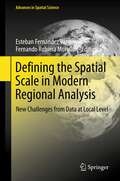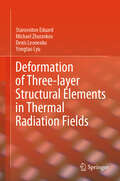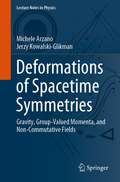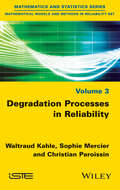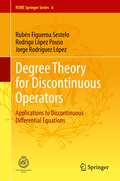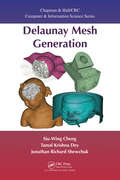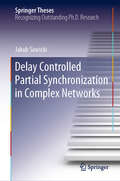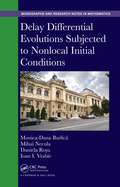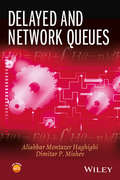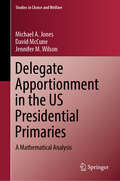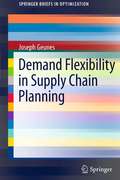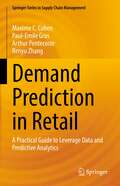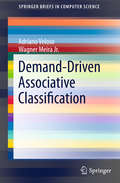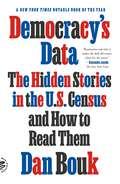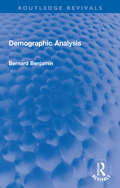- Table View
- List View
Defining the Spatial Scale in Modern Regional Analysis
by Esteban Fernández Vázquez Fernando Rubiera MorollónThis book explores different approaches to defining the concept of region depending on the specific question that needs to be answered. While the typical administrative spatial data division fits certain research questions well, in many cases, defining regions in a different way is fundamental in order to obtain significant empirical evidence. The book is divided into three parts: The first part is dedicated to a methodological discussion of the concept of region and the different potential approaches from different perspectives. The problem of having sufficient information to define different regional units is always present. This justifies the second part of the book, which focuses on the techniques of ecological inference applied to estimating disaggregated data from observable aggregates. Finally, the book closes by presenting several applications that are in line with the functional areas definition in regional analysis.
Deformation of Three-layer Structural Elements in Thermal Radiation Fields
by Yongtao Lyu Michael Zhuravkov Starovoitov Eduard Denis LeonenkoThis book methodically details the formulations and approaches to solve boundary value problems, which are essential for determining the stress–strain states in three-layer rods and plates subjected to both single and quasi-static variable loads in thermal radiation and force fields. It duly considers the complex influences on the physically nonlinear properties of the materials in each layer. The book offers several innovative analytical solutions and a numerical parametric analysis of the stress–strain scenarios in these structures. It describes the deformation of physically nonlinear media in thermoradiational fields within the small elastic-plastic deformations theory framework. The work explores variational problem-solving methods and the elastic solution method. It presents a formula for calculating the temperature within a three-layer assembly, derived by averaging the thermophysical properties of the materials across the layers' thickness. Additionally, the book includes an analysis of the attenuation of neutron flux as it passes through a three-layer element.
Deformations of Spacetime Symmetries: Gravity, Group-Valued Momenta, and Non-Commutative Fields (Lecture Notes in Physics #986)
by Michele Arzano Jerzy Kowalski-GlikmanThis monograph provides an introduction to deformations of Poincaré symmetries focusing on models with a Lie group momentum space and associated non-commutative space-times. The emphasis is put on the emergence of such structures from quantum gravity, their mathematical features described in terms of Hopf algebras and applications to particle kinematics and field theory. Part I of this work focuses on the link between gravity and deformed symmetries in the case of 2+1 and 3+1 space-time dimensions. Part II is devoted to the description of classical particles with group valued momenta, their phase spaces and kinematics. The last part of these notes provides an introduction to the basic features of classical and quantum field theory on κ-Minkowski space-time, the prototypical example of non-commutative space-time exhibiting deformed Poincaré symmetry. The text, being the first providing a detailed overview of these topics, is primarily intended for researchers and graduate students interested in non-commutative field theories and quantum gravity phenomenology.
Degenerate Differential Equations in Banach Spaces (Chapman & Hall/CRC Pure and Applied Mathematics)
by Angelo Favini Atsushi YagiThis work presents a detailed study of linear abstract degenerate differential equations, using both the semigroups generated by multivalued (linear) operators and extensions of the operational method from Da Prato and Grisvard. The authors describe the recent and original results on PDEs and algebraic-differential equations, and establishes the analyzability of the semigroup generated by some degenerate parabolic operators in spaces of continuous functions.
Degenerate Diffusion Operators Arising in Population Biology (Annals of Mathematics Studies #185)
by Charles L. Epstein Rafe MazzeoThis book provides the mathematical foundations for the analysis of a class of degenerate elliptic operators defined on manifolds with corners, which arise in a variety of applications such as population genetics, mathematical finance, and economics. The results discussed in this book prove the uniqueness of the solution to the Martingale problem and therefore the existence of the associated Markov process. Charles Epstein and Rafe Mazzeo use an "integral kernel method" to develop mathematical foundations for the study of such degenerate elliptic operators and the stochastic processes they define. The precise nature of the degeneracies of the principal symbol for these operators leads to solutions of the parabolic and elliptic problems that display novel regularity properties. Dually, the adjoint operator allows for rather dramatic singularities, such as measures supported on high codimensional strata of the boundary. Epstein and Mazzeo establish the uniqueness, existence, and sharp regularity properties for solutions to the homogeneous and inhomogeneous heat equations, as well as a complete analysis of the resolvent operator acting on Hölder spaces. They show that the semigroups defined by these operators have holomorphic extensions to the right half-plane. Epstein and Mazzeo also demonstrate precise asymptotic results for the long-time behavior of solutions to both the forward and backward Kolmogorov equations.
Degenerate Nonlinear Diffusion Equations
by Angelo Favini Gabriela MarinoschiThe aim of these notes is to include in a uniform presentation style several topics related to the theory of degenerate nonlinear diffusion equations, treated in the mathematical framework of evolution equations with multivalued m-accretive operators in Hilbert spaces. The problems concern nonlinear parabolic equations involving two cases of degeneracy. More precisely, one case is due to the vanishing of the time derivative coefficient and the other is provided by the vanishing of the diffusion coefficient on subsets of positive measure of the domain. From the mathematical point of view the results presented in these notes can be considered as general results in the theory of degenerate nonlinear diffusion equations. However, this work does not seek to present an exhaustive study of degenerate diffusion equations, but rather to emphasize some rigorous and efficient techniques for approaching various problems involving degenerate nonlinear diffusion equations, such as well-posedness, periodic solutions, asymptotic behaviour, discretization schemes, coefficient identification, and to introduce relevant solving methods for each of them.
Degenerate and Other Problems
by Abduhamid DzhuraevThis Monograph contains a collection of problems arising in partial differential equations investigated by means of complex analysis approached in elementary ways.
Degradation Processes in Reliability
by Waltraud Kahle Sophie Mercier Christian Paroissin"Degradation process" refers to many types of reliability models, which correspond to various kinds of stochastic processes used for deterioration modeling. This book focuses on the case of a univariate degradation model with a continuous set of possible outcomes. The envisioned univariate models have one single measurable quantity which is assumed to be observed over time. The first three chapters are each devoted to one degradation model. The last chapter illustrates the use of the previously described degradation models on some real data sets. For each of the degradation models, the authors provide probabilistic results and explore simulation tools for sample paths generation. Various estimation procedures are also developed.
Degree Theory for Discontinuous Operators: Applications to Discontinuous Differential Equations (RSME Springer Series #6)
by Rodrigo López Pouso Rubén Figueroa Sestelo Jorge Rodríguez LópezThis unique book contains a generalization of the Leray-Schauder degree theory which applies for wide and meaningful types of discontinuous operators. The discontinuous degree theory introduced in the first section is subsequently used to prove new, applicable, discontinuous versions of many classical fixed-point theorems such as Schauder’s. Finally, readers will find in this book several applications of those discontinuous fixed-point theorems in the proofs of new existence results for discontinuous differential problems. Written in a clear, expository style, with the inclusion of many examples in each chapter, this book aims to be useful not only as a self-contained reference for mature researchers in nonlinear analysis but also for graduate students looking for a quick accessible introduction to degree theory techniques for discontinuous differential equations.
Deine, meine, unsere Toten: Über die Aushandlung der Deutungshoheit am Lebensende
by Viola AbermetIn der modernen Dienstleistungsgesellschaft werden spezielle wie alltägliche Aufgaben in die Hände von Dienstleistenden übergeben. Gerade im Bereich des Sterbens entsteht die Herausforderung, eine besonders emotionale und sensible Arbeit verrichten zu müssen, in einem der letzten Bereiche, die noch stark mit Familie assoziiert werden. So schließt sich die Frage an, wie dem Übel der Kommodifizierung des Sterbens in der Praxis begegnet wird: Wer darf wie über Tod und Sterben entscheiden? In teilnehmender Beobachtung im Pflegeheim, Hospiz, Bestattungswesen, Friedhof, Krematorium und Palliative Care Team wird der Frage nachgegangen, wie am Lebensende im Beziehungskomplex von Dienstleistenden, Sterbenden und Angehörigen die Deutungshoheit des angemessenen Sterbens ausgehandelt wird. Zu sehen ist ein pragmatisches Spiel mit Elementen der Fürsorge- und Dienstleistungswelten, das ein komplexes und dynamisches Beziehungsgefüge wechselseitiger Dependenzen entstehen lässt.
Delaunay Mesh Generation (Chapman & Hall/CRC Computer and Information Science Series)
by Siu-Wing Cheng Tamal K. Dey Jonathan ShewchukWritten by authors at the forefront of modern algorithms research, Delaunay Mesh Generation demonstrates the power and versatility of Delaunay meshers in tackling complex geometric domains ranging from polyhedra with internal boundaries to piecewise smooth surfaces. Covering both volume and surface meshes, the authors fully explain how and why thes
Delay Controlled Partial Synchronization in Complex Networks (Springer Theses)
by Jakub SawickiThe focus of this thesis are synchronization phenomena in networks and their intrinsic control through time delay, which is ubiquitous in real-world systems ranging from physics and acoustics to neuroscience and engineering. We encounter synchronization everywhere and it can be either a helpful or a detrimental mechanism. In the first part, after a survey of complex nonlinear systems and networks, we show that a seemingly simple system of two organ pipes gives birth to complex bifurcation and synchronization scenarios. Going from a 2-oscillator system to a ring of oscillators, we encounter the intriguing phenomenon of chimera states which are partial synchrony patterns with coexisting domains of synchronized and desynchronized dynamics. For more than a decade scientist have tried to solve the puzzle of this spontaneous symmetry-breaking emerging in networks of identical elements. We provide an analysis of initial conditions and extend our model by the addition of time delay and fractal connectivities. In the second part, we investigate partial synchronization patterns in a neuronal network and explain dynamical asymmetry arising from the hemispheric structure of the human brain. A particular focus is on the novel scenario of partial relay synchronization in multiplex networks. Such networks allow for synchronization of the coherent domains of chimera states via a remote layer, whereas the incoherent domains remain desynchronized. The theoretical framework is demonstrated with different generic models.
Delay Differential Equations and Applications to Biology (Forum for Interdisciplinary Mathematics)
by Fathalla A. RihanThis book discusses the numerical treatment of delay differential equations and their applications in bioscience. A wide range of delay differential equations are discussed with integer and fractional-order derivatives to demonstrate their richer mathematical framework compared to differential equations without memory for the analysis of dynamical systems. The book also provides interesting applications of delay differential equations in infectious diseases, including COVID-19. It will be valuable to mathematicians and specialists associated with mathematical biology, mathematical modelling, life sciences, immunology and infectious diseases.
Delay Differential Evolutions Subjected to Nonlocal Initial Conditions (Chapman & Hall/CRC Monographs and Research Notes in Mathematics #24)
by Monica-Dana Burlică Mihai Necula Daniela Roșu Ioan I. VrabieFilling a gap in the literature, Delay Differential Evolutions Subjected to Nonlocal Initial Conditions reveals important results on ordinary differential equations (ODEs) and partial differential equations (PDEs). It presents very recent results relating to the existence, boundedness, regularity, and asymptotic behavior of global solutions for differential equations and inclusions, with or without delay, subjected to nonlocal implicit initial conditions. After preliminaries on nonlinear evolution equations governed by dissipative operators, the book gives a thorough study of the existence, uniqueness, and asymptotic behavior of global bounded solutions for differential equations with delay and local initial conditions. It then focuses on two important nonlocal cases: autonomous and quasi-autonomous. The authors next discuss sufficient conditions for the existence of almost periodic solutions, describe evolution systems with delay and nonlocal initial conditions, examine delay evolution inclusions, and extend some results to the multivalued case of reaction-diffusion systems. The book concludes with results on viability for nonlocal evolution inclusions.
Delay Ordinary and Partial Differential Equations (Advances in Applied Mathematics)
by Andrei D. Polyanin Alexei I. Zhurov Vsevolod G. SorokinDelay Ordinary and Partial Differential Equations is devoted to linear and nonlinear ordinary and partial differential equations with constant and variable delay. It considers qualitative features of delay differential equations and formulates typical problem statements. Exact, approximate analytical and numerical methods for solving such equations are described, including the method of steps, methods of integral transformations, method of regular expansion in a small parameter, method of matched asymptotic expansions, iteration-type methods, Adomian decomposition method, collocation method, Galerkin-type projection methods, Euler and Runge-Kutta methods, shooting method, method of lines, finite-difference methods for PDEs, methods of generalized and functional separation of variables, method of functional constraints, method of generating equations, and more. The presentation of the theoretical material is accompanied by examples of the practical application of methods to obtain the desired solutions. Exact solutions are constructed for many nonlinear delay reaction-diffusion and wave-type PDEs that depend on one or more arbitrary functions. A review is given of the most common mathematical models with delay used in population theory, biology, medicine, economics, and other applications. The book contains much new material previously unpublished in monographs. It is intended for a broad audience of scientists, university professors, and graduate and postgraduate students specializing in applied and computational mathematics, mathematical physics, mechanics, control theory, biology, medicine, chemical technology, ecology, economics, and other disciplines. Individual sections of the book and examples are suitable for lecture courses on applied mathematics, mathematical physics, and differential equations for delivering special courses and for practical training.
Delay-Coupled Complex Systems
by Valentin FlunkertThis work addresses time-delay in complex nonlinear systems and, in particular, its applications in complex networks; its role in control theory and nonlinear optics are also investigated. Delays arise naturally in networks of coupled systems due to finite signal propagation speeds and are thus a key issue in many areas of physics, biology, medicine, and technology. Synchronization phenomena in these networks play an important role, e.g., in the context of learning, cognitive and pathological states in the brain, for secure communication with chaotic lasers or for gene regulation. The thesis includes both novel results on the control of complex dynamics by time-delayed feedback and fundamental new insights into the interplay of delay and synchronization. One of the most interesting results here is a solution to the problem of complete synchronization in general networks with large coupling delay, i.e., large distances between the nodes, by giving a universal classification of networks that has a wide range of interdisciplinary applications.
Delayed and Network Queues
by Aliakbar Montazer Haghighi Dimitar P. MishevPresents an introduction to differential equations, probability, and stochastic processes with real-world applications of queues with delay and delayed network queues Featuring recent advances in queueing theory and modeling, Delayed and Network Queues provides the most up-to-date theories in queueing model applications. Balancing both theoretical and practical applications of queueing theory, the book introduces queueing network models as tools to assist in the answering of questions on cost and performance that arise throughout the life of a computer system and signal processing. Written by well-known researchers in the field, the book presents key information for understanding the essential aspects of queues with delay and networks of queues with unreliable nodes and vacationing servers. Beginning with simple analytical fundamentals, the book contains a selection of realistic and advanced queueing models that address current deficiencies. In addition, the book presents the treatment of queues with delay and networks of queues, including possible breakdowns and disruptions that may cause delay. Delayed and Network Queues also features: Numerous examples and exercises with applications in various fields of study such as mathematical sciences, biomathematics, engineering, physics, business, health industry, and economics A wide array of practical applications of network queues and queueing systems, all of which are related to the appropriate stochastic processes Up-to-date topical coverage such as single- and multiserver queues with and without delays, along with the necessary fundamental coverage of probability and difference equations Discussions on queueing models such as single- and multiserver Markovian queues with balking, reneging, delay, feedback, splitting, and blocking, as well as their role in the treatment of networks of queues with and without delay and network reliability Delayed and Network Queues is an excellent textbook for upper-undergraduate and graduate-level courses in applied mathematics, queueing theory, queueing systems, probability, and stochastic processes. The book is also an ideal reference for academics and practitioners in mathematical sciences, biomathematics, operations research, management, engineering, physics, business, economics, health industry, and industrial engineering. Aliakbar Montazer Haghighi, PhD, is Professor and Head of the Department of Mathematics at Prairie View A&M University, USA, as well as founding Editor-in-Chief of Applications and Applied Mathematics: An International Journal (AAM). His research interests include probability, statistics, stochastic processes, and queueing theory. Among his research publications and books, Dr. Haghighi is the coauthor of Difference and Differential Equations with Applications in Queueing Theory (Wiley, 2013). Dimitar P. Mishev, PhD, is Professor in the Department of Mathematics at Prairie View A&M University, USA. His research interests include differential and difference equations and queueing theory. The author of numerous research papers and three books, Dr. Mishev is the coauthor of Difference and Differential Equations with Applications in Queueing Theory (Wiley, 2013).
Delays and Interconnections: Methodology, Algorithms and Applications (Advances in Delays and Dynamics #10)
by Alexandre Seuret Islam Boussaada Rifat Sipahi Giorgio ValmorbidaThis book contains advances on the theory and applications of time-delay systems with particular focus on interconnected systems. The methods for stability analysis and control design are based on time-domain and frequency-domain approaches, for continuous-time and sampled-data systems, linear and nonlinear systems. This volume is a valuable source of reference for control practitioners, graduate students, and scientists researching practical as well as theoretical solutions to a variety of control problems inevitably influenced by the presence of time delays. The contents are organized in three parts: Interconnected Systems analysis, Modeling and and Analysis for Delay systems, and Stabilization and Control Strategies for Delay Systems. This volume presents a selection of 19 contributions presented in the 4th DelSys Workshop which took place in Gif-sur-Yvette, France November 25-27, 2015.
Delegate Apportionment in the US Presidential Primaries: A Mathematical Analysis (Studies in Choice and Welfare)
by Michael A. Jones David McCune Jennifer M. WilsonThis book provides a comprehensive mathematical description and analysis of the delegate allocation processes in the US Democratic and Republican presidential primaries, focusing on the role of apportionment methods and the effect of thresholds—the minimum levels of support required to receive delegates. The analysis involves a variety of techniques, including theoretical arguments, simplicial geometry, Monte Carlo simulation, and examination of presidential primary data from 2004 to 2020. The book is divided into two parts: Part I defines the classical apportionment problem and explains how the implementation and goals of delegate apportionment differ from those of apportionment for state representation in the US House of Representatives and for party representation in legislatures based on proportional representation. The authors then describe how delegates are assigned to states and congressional districts and formally define the delegate apportionment methods used in each state by the two major parties to allocate delegates to presidential candidates. Part II analyzes and compares the apportionment methods introduced in Part I based on their level of bias and adherence to various notions of proportionality. It explores how often the methods satisfy the quota condition and quantifies their biases in favor or against the strongest and weakest candidates. Because the methods are quota-based, they are susceptible to classical paradoxes like the Alabama and population paradoxes. They also suffer from other paradoxes that are more relevant in the context of delegate apportionment such as the elimination and aggregation paradoxes. The book evaluates the extent to which each method is susceptible to each paradox. Finally, it discusses the appointment of delegates based on divisor methods and notions of regressive proportionality.This book appeals to scholars and students interested in mathematical economics and political science, with an emphasis on apportionment and social choice theory.
Demand Flexibility in Supply Chain Planning
by Joseph GeunesThis work encapsulates the essential developments in this field into a single resource, as well as to set an agenda for further development in the field. This brief focuses on the demand flexibility in supply chains with fragmented results distributed throughout the literature. These results have strong implications for managing real-world complex operations planning problems. This book exploits dimensions of demand flexibility in supply chains and characterizes the best fit between demand properties and operations capabilities and constraints. The origins and seminal works are traced in integrated demand and operations planning and an in-depth documentation is provided for the current state of the art. Systems with inherent costs and constraints that must respond to some set of demands at a minimum cost are examined. Crucial unanswered questions are explored and the high-value research directions are highlighted for both practice and for the development of new and interesting optimization models and algorithms.
Demand Forecasting for Executives and Professionals
by Stephan Kolassa Bahman Rostami-Tabar Enno SiemsenThis book surveys what executives who make decisions based on forecasts and professionals responsible for forecasts should know about forecasting. It discusses how individuals and firms should think about forecasting and guidelines for good practices. It introduces readers to the subject of time series, presents basic and advanced forecasting models, from exponential smoothing across ARIMA to modern Machine Learning methods, and examines human judgment's role in interpreting numbers and identifying forecasting errors and how it should be integrated into organizations. This is a great book to start learning about forecasting if you are new to the area or have some preliminary exposure to forecasting. Whether you are a practitioner, either in a role managing a forecasting team or at operationally involved in demand planning, a software designer, a student or an academic teaching business analytics, operational research, or operations management courses, the book can inspire you to rethink demand forecasting. No prior knowledge of higher mathematics, statistics, operations research, or forecasting is assumed in this book. It is designed to serve as a first introduction to the non-expert who needs to be familiar with the broad outlines of forecasting without specializing in it. This may include a manager overseeing a forecasting group, or a student enrolled in an MBA program, an executive education course, or programs not specialising in analytics. Worked examples accompany the key formulae to show how they can be implemented. Key Features: While there are many books about forecasting technique, very few are published targeting managers. This book fills that gap. It provides the right balance between explaining the importance of demand forecasting and providing enough information to allow a busy manager to read a book and learn something that can be directly used in practice. It provides key takeaways that will help managers to make difference in their companies.
Demand Prediction in Retail: A Practical Guide to Leverage Data and Predictive Analytics (Springer Series in Supply Chain Management #14)
by Maxime C. Cohen Paul-Emile Gras Arthur Pentecoste Renyu ZhangFrom data collection to evaluation and visualization of prediction results, this book provides a comprehensive overview of the process of predicting demand for retailers. Each step is illustrated with the relevant code and implementation details to demystify how historical data can be leveraged to predict future demand. The tools and methods presented can be applied to most retail settings, both online and brick-and-mortar, such as fashion, electronics, groceries, and furniture. This book is intended to help students in business analytics and data scientists better master how to leverage data for predicting demand in retail applications. It can also be used as a guide for supply chain practitioners who are interested in predicting demand. It enables readers to understand how to leverage data to predict future demand, how to clean and pre-process the data to make it suitable for predictive analytics, what the common caveats are in terms of implementation and how to assess prediction accuracy.
Demand-Driven Associative Classification
by Wagner Meira Jr. Adriano VelosoThe ultimate goal of machines is to help humans to solve problems. Such problems range between two extremes: structured problems for which the solution is totally defined (and thus are easily programmed by humans), and random problems for which the solution is completely undefined (and thus cannot be programmed). Problems in the vast middle ground have solutions that cannot be well defined and are, thus, inherently hard to program. Machine Learning is the way to handle this vast middle ground, so that many tedious and difficult hand-coding tasks would be replaced by automatic learning methods. There are several machine learning tasks, and this work is focused on a major one, which is known as classification. Some classification problems are hard to solve, but we show that they can be decomposed into much simpler sub-problems. We also show that independently solving these sub-problems by taking into account their particular demands, often leads to improved classification performance.
Democracy's Data: The Hidden Stories in the U.S. Census and How to Read Them
by Dan BoukFrom the historian Dan Bouk, a lesson in reading between the lines of the U.S. census to uncover the stories behind the data.The census isn’t just a data-collection process; it’s a ritual, and a tool, of American democracy. Behind every neat grid of numbers is a collage of messy, human stories—you just have to know how to read them.In Democracy’s Data, the data historian Dan Bouk examines the 1940 U.S. census, uncovering what those numbers both condense and cleverly abstract: a universe of meaning and uncertainty, of cultural negotiation and political struggle. He introduces us to the men and women employed as census takers, bringing us with them as they go door to door, recording the lives of their neighbors. He takes us into the makeshift halls of the Census Bureau, where hundreds of civil servants, not to mention machines, labored with pencil and paper to divide and conquer the nation’s data. And he uses these little points to paint bigger pictures, such as of the ruling hand of white supremacy, the place of queer people in straight systems, and the struggle of ordinary people to be seen by the state as they see themselves.The 1940 census is a crucial entry in American history, a controversial dataset that enabled the creation of New Deal era social programs, but that also, with the advent of World War Two, would be weaponized against many of the citizens whom it was supposed to serve. In our age of quantification, Democracy’s Data not only teaches us how to read between the lines but gives us a new perspective on the relationship between representation, identity, and governance today.
Demographic Analysis (Routledge Revivals)
by Bernard BenjaminFirst published in 1968, Demographic Analysis was written to provide a comprehensive account of demographic methods for those with a need to understand population movements. The book provides an introduction to some of the key tools used by demographers and the principal sources of population data. Beginning with an overview of the scope, content and use of the population census, it then examines methods for measuring births, deaths, and migration before setting out the methodology for determining the contributions of these elements to population change and estimating past or future changes. The book also explores sickness as a population characteristic and a way of better understanding mortality variations.
